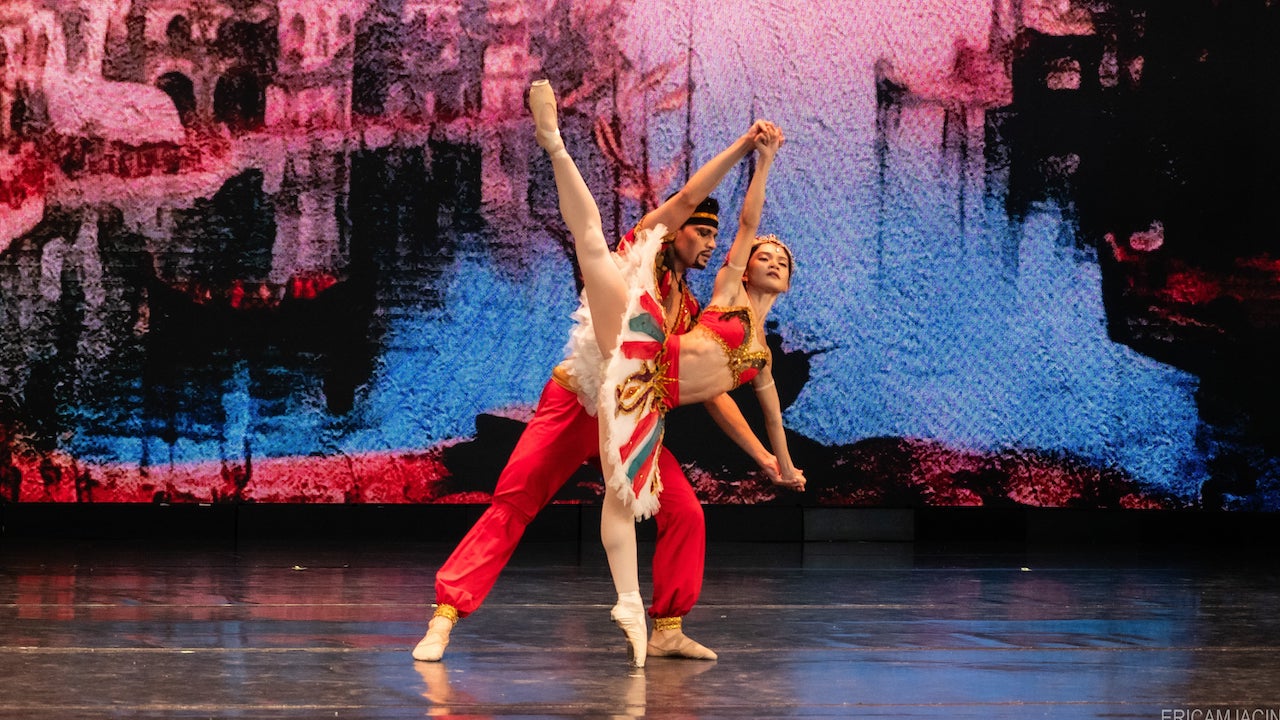
REVIEW: Ballet Manila’s Reimagined ‘Le Corsaire’ Lets Principals Shine
This Ballet Manila production, reimagined by Lisa Macuja Elizalde, is a resounding success, re-establishing the company as a strong contender in the classics.
Lisa Macuja Elizalde often uses the phrases, “from page to stage” or “from book to ballet.” These clever phrases adequately reflect what Ballet Manila is trying to do with its 2024 season.
They opened with the story ballet Le Corsaire, loosely based on Lord Byron’s poem “The Corsaire,” which has inspired numerous ballet adaptations since its premiere in May 1858. While Joseph Mazilier created the original staging, Marius Petipa’s revivals introduced new elements to the ballet. 166 years later, ballet companies are still coming up with new restagings of this ballet, simply because of its exciting plot that allows for a lot of artistic liberties.
Ballet Manila was the first ballet company to stage Le Corsaire in Asia in 1998. Since then, they have faithfully staged the Russian version and libretto eight times, much to the delight of their loyal audience. But this year, Artistic Director Lisa Macuja Elizalde opted to present a reimagined ballet.
Archaic Ballet
Briefly, Le Corsaire follows Conrad, a pirate who falls in love with Medora, sold to a wealthy Pasha as a slave. He and his crew embark on a journey to rescue her, facing obstacles from villains Lankadem and Birbanto.
In all honesty, the story of Le Corsaire is the most archaic and sexist of all the story ballets. It’s a story that does not reflect the current times and depicts women in the worst light, perpetuating their objectification and commodification. The opening scene says it all: Lankadem (slave seller) presents his fleet of women and puts a price on each one.
The ballet shows a narrative that women need to be saved over and over again, coupled with instances of violence and deceit. Everyone who has seen the ballet knows that the storyline appears irreparably flawed, but kudos to those who try to make it more appropriate for modern audiences.
The Old and the New
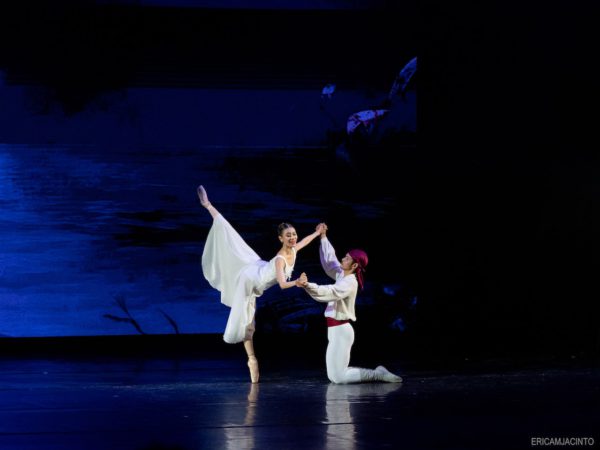
Abigail Oliveiro as Medora and Mark Sumaylo as Conrad; Photo Credit: Erica Feliz Marquez-Jacinto
After much thought and research, some of the changes that Lisa Macuja Elizalde implemented in this version were similar to earlier stagings of the ballet. Just like her version, there was no shipwreck prologue. The omission of this prologue leaves a void in understanding the nature of Conrad and Medora’s relationship. Without it, the presence of pirates in a settled town remains puzzling, as pirates are typically nomadic.
The characters of Gulnara and Medora are Pasha’s possessions but Pasha chose Medora over Gulnara to be his wife. In Ballet Manila’s newest version, Gulnara (who is seen in the first act as distraught at the thought of being sold to Pasha) falls in love with Pasha and tricks him into marrying her. While consistent with earlier versions, Gulnara’s declaration of love seems improbable. It’s hard to swallow that Gulnara–one of Pasha’s slaves–would shift so easily from a sad slave to a scheming lover. I found it difficult to believe Pasha could be deceived, especially considering the casting. It seemed improbable that he would mistake the petite Shaira Comeros for the statuesque Abigail Oliveiro on such a significant occasion as his wedding. The mere addition of a veil was all it took to persuade him.
In Ballet Manila’s new version, Act 1 was just filled with aesthetically pleasing scenes. Medora, played by Oliveiro, emerged from a beautiful balcony. Conrad, played by Mark Sumaylo, reached out to her and the couple looked like something from a fashion magazine. Oliveiro was dazzling with her white tutu glittering under the spotlight. Sumaylo looked every bit the lead.
In this rendition, the iconic portrayal of Medora on a platform as a woman being sold, along with the Palestinian and Arabian dances, was omitted. I consider this a commendable decision. Instead, these were replaced by the odalisques, one of the most awaited segments of the ballet.
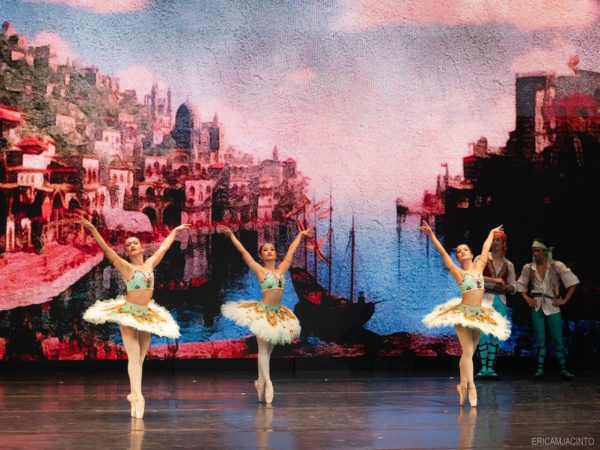
L-R: Jessa Balote, Pia Dames, Pearl Dames as the Odalisques; Photo Credit: Erica Feliz Marquez-Jacinto
The final fight scene between Birbanto and Conrad culminated with dramatic gunshots piercing the air. The audience held its breath as Birbanto fell lifeless and Ali lay injured. The scene concluded with Medora and Conrad setting sail into the sunset, accompanied by Ali and the remaining pirates.
The earlier versions of Le Corsaire end with a glorious visual of a shipwreck. This version follows this line of thought and ends it with a beautiful pas de deux showing Medora and Conrad conquering love against a backdrop of the sun setting. Although the pas de deux was particularly lovely, I couldn’t shake off a sense of unease as the curtains fell. While audiences typically relish a satisfying conclusion, this one felt rather grim. The couple lost their friends (including Ali, historically Le Corsair’s poster boy) and all their treasures, leaving them without a home. Upon reflection, it becomes apparent that the story actually ends in tragedy.
Technical Demands
The technical demands of this ballet were very high. With two principal pairs and six soloist roles, the inventory of difficult steps was like a full buffet of tricks. As an audience member appreciative of the skill required, I found myself fervently rooting for the dancers as they gracefully interpreted the music. Ballet Manila’s Principals and Soloists executed their roles flawlessly, exuding an inspiring sense of composure that filled me with pride. Their performance was deserving of the spotlight.
The curtains rose to reveal Lankadem played by Noah Esplana who just electrified the audience with a sure-footed pirouette with six revolutions. To make it even better, he repeats it, performing another impressive quintuple pirouette. This author sat a little straighter and clutched her camera tightly, ready for his next move. His charisma was undeniable.
Based on his debut as a soloist, he shows promising potential to become a true star. While his execution of jumps and turns could use more precision and clarity, there were moments of brilliance that ignited excitement. Despite occasional instances of floppy footwork, his performance left me intrigued. I’m eager to follow his journey and see how he progresses in future roles.
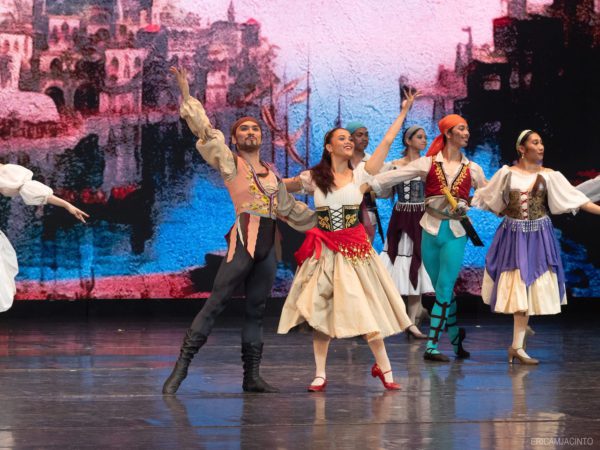
Romeo Peralta as Birbanto, Rissa May Camaclang as Birbanto’s Wench; Photo Credit: Erica Feliz Marquez-Jacinto
Back in 2013, Mark Sumaylo debuted as Conrad in Le Corsaire and even then, Sumaylo showed that he had everything he needed to be a star. In this production, he was confident and carefree with the maturity of a seasoned Principal dancer. He now has the clarity of movement and mime. His partnering skills are also something to commend because he consistently enhances the performances of his female counterparts.
Oliveiro, portraying his love interest, played a pivotal role in the ballet’s success. She had a sophisticated exuberance that drew the audience’s attention. Balancing elegance with energy is a delicate task, yet she managed it effortlessly, delivering a performance that was a sheer delight. Despite the very technical choreography that requires a dancer to reel in the emotion, she danced with complete joy and emotional involvement in every scene. Her extensions were elongated and her epaulement and epaule (shoulder and arm twists while doing extensions) were luxurious. Her sustained balances were thrilling and ultimately satisfying to watch. Her joyful leaps evoked smiles and a sense of flight, as if we were soaring alongside her.
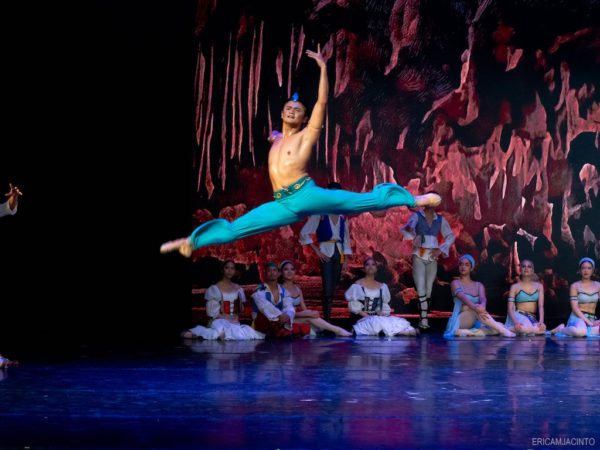
Joshua Enciso as Ali; Photo Credit: Erica Feliz Marquez-Jacinto
Joshua Enciso portrayed the role of Ali with notable proficiency, quickly capturing the attention of balletomanes with his more polished dancing. Shaira Comeros as Gulnara had the emotional mettle to stir a crowd. Her unwavering portrayal of the tearful woman being sold off was piercing. Her movements were so centered that even when she changed the flow or step it would remain undetected by an untrained eye. She was every bit a Principal dancer– calm, composed, and seamless.
Soloists Pia Dames, Pearl Dames, and Jessa Balote performing the odalisque were meticulously clean. Romeo Peralta and Rissa Camaclang as Birbanto and Birbanto’s mistress were convincing in both movement and character. Pasha, played by Gerardo Franciso, tickled everyone with his humor, which made me wish that he and Esplana had more comedic moments.
Back to Classic
The primary challenge in reimagining Le Corsaire lay in its problematic narrative, but this ballet was never really about loving the storyline. Rather, it thrives on the exhilarating choreography and captivating dramatics. In this regard, Ballet Manila’s production stands as a resounding success, re-establishing the company as a strong contender in the classics. Their soloists and corps de ballet elevate every visit to the theater, showcasing a level of excellence to their audiences in every performance.
Tickets: P1,500, P1,200
Show Dates: February 24-25, March 3
Venue: Aliw Theater
Running Time: 2.5 Hours
Credits:
Artistic Director: Lisa Macuja Elizalde
Retelling: Lisa Macuja Elizalde
Choreography: Marius Petipa
Cast:
Conrad : Mark Sumaylo
Medora : Abigail Oliveiro
Lankadem : Noah Esplana
Gulnare : Shaira Comeros
Ali: Joshua Enciso
Pasha : Gerardo Francisco
Birbanto: Romeo Peralta
Birbanto’s Wench: Rissa May Camaclang
Odalisques: Pia Dames, Pearl Dames, Jessa Balote


Comments